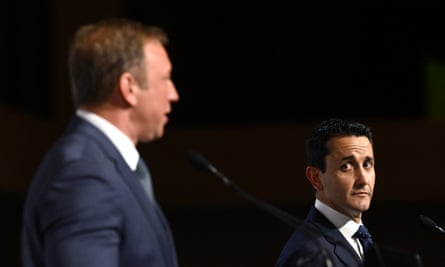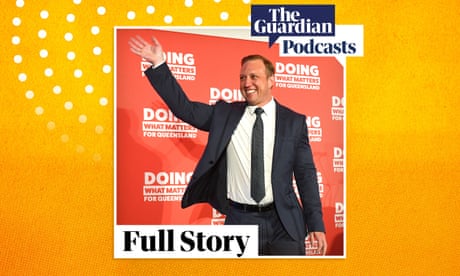Extract from The Guardian
The Liberal National party’s reluctance to say how it would meet the state’s emissions reduction targets while backing coal-fired power has become an election issue.
Sat 19 Oct 2024 01.00 AEDT
Two years ago, former US vice-president and climate change campaigner Al Gore took to a pre-Elon Musk Twitter to congratulate Queensland for plotting a route to get the state off coal-fired power by the end of the next decade.
If this was possible in a state with “one of the most carbon intensive energy supplies” anywhere, Gore wrote, then “we need to see action like this around the world”.
The state government had announced a $69bn energy and jobs plan. Eighteen months later, the government legislated an emissions target celebrated by climate advocates.
As Queenslanders head to the polls later this month, the enthusiasm from climate campaigners and the renewables industry over Queensland’s trajectory is being heavily tested.
The Liberal National party’s reluctance to say how it would meet the state’s emissions-reduction targets while backing coal-fired power is the stressor.
When asked during the campaign if the LNP would keep Queensland’s mostly state-owned coal plants open “indefinitely”, party leader David Crisafulli replied: “I guess the answer to that is yes.”
“That word ‘indefinitely’ is pretty much all I’ve been thinking about,” said Dave Copeman, director of the Queensland Conservation Council (QCC).

‘Loss of momentum’
Renewable energy generation in Queensland has almost quadrupled since 2018, making up about 28% of the state’s electricity.
“I’m very worried we will see a real loss of momentum,” said Copeman. “And what Queensland does can shape Australia, and what Australia does can influence Asia. I don’t think people get the significance.”
In April, the state government led by the premier, Steven Miles, put into law its net zero emissions by 2050 target and a new 2035 goal to cut emissions by 75% by 2035, based on 2005 levels, that was celebrated by climate advocates.
Also legislated were targets to have 50% of electricity coming from renewables by 2030, rising to 70% by 2032 and 80% by 2035.
The LNP backed the emissions targets but didn’t support the renewables targets, with Crisafulli saying, “We don’t believe there’s a credible path to get there.”
“We have a plan that revolves around solar, pumped hydro,” Crisafulli has said, but so far, no actual plan has been released. When asked on the campaign if he still backed the 2035 climate target, he would only say his focus was on net zero by 2050.
Conservation and climate advocacy groups took their frustration into the pages of NewsCorp’s Courier-Mail this week, publishing a full-page open letter saying “Queenslanders need energy certainty, not chaos.”

Nuclear uncertainty
Into this uncertainty comes nuclear.
Crisafulli says the federal opposition’s hopes of putting nuclear reactors at two sites in Queensland “is not in our plans” but the state’s legislation banning nuclear includes a clause that a state plebiscite must be called if the federal government shows intent to build one. That plebiscite trigger could be pulled if Peter Dutton’s Coalition wins the next election.
Queensland is Australia’s highest greenhouse gas emitter and just over a third of those emissions come from electricity generation. Renewables will also be key to cutting emissions across other sectors, including agriculture and heavy industry.
The Labor government pointed out in April that it had reached its 2030 emissions target, considered to be the least ambitious of all the states, eight years early.
But almost all of the emissions reductions were gained from an apparent drop in deforestation and increased vegetation growth.
In 2005, the net emissions from forest clearing and regrowth stood at 66Mt CO2-equivalent.
In 2002, the most recent year of data, Queensland was claiming this sector was now actually sequestering 16Mt CO2-e – a turnaround from a major source of emissions to a benefit, but using data that some scientists say likely hides the true extent of those emissions.
Electricity sector emission have seen only modest falls since 2018 and the sector was emitting more in 2022 than it did in 2005.
Clare Silcock, energy strategist at QCC, said: “That’s because Queensland’s coal-fired power stations have remained pretty stable and the renewable energy that has come in has just met increasing demand and pushed gas out of the system.”
Keeping coal-fired power plants open for longer, she said, would probably push up electricity costs while slowing investment in renewables.
Supergrid’s future?
The backbone of the state government’s plan to get off coal is a “supergrid” of solar, wind, transmission lines, renewable energy zones and electricity storage, including batteries and pumped hydro.
The planned state-owned Pioneer-Burdekin pumped hydro scheme near Mackay – more than double the size of Snowy 2.0 – is seen as a critical part of the supergrid and would act like a giant battery that could release energy over 24 hours.
But the LNP has said repeatedly it would scrap it if elected, backing smaller pumped hydro projects instead (government data shows five are being planned across the state).
Dr Dylan McConnell, an energy systems analyst at the University of New South Wales, said there was no reason why Queensland couldn’t reach its existing renewables targets without the Pioneer-Burdekin project.
There was an “iron law”, McConnell said, that mega projects such as Pioneer-Burdekin would see cost blowouts and delays. Several smaller projects could help “diversify the risk” of delays.
But McConnell pointed to falling costs of batteries, with some projections suggesting price drops of 40% or more by 2030.
“By the time these [pumped hydro] projects are built, it could be cheaper to build chemical storage,” he said.
On the right track
Even before Crisafulli’s statements on coal, Queensland clean energy executives told a research firm that investment decisions were being affected by policy uncertainty, and this was being exacerbated “by the impending 2024 state election”.
A vast majority of executives told the researchers, commissioned by Queensland Renewable Energy Council (QREC), they thought Queensland’s energy transition was “on the right track”.
Katie-Anne Mulder, chief executive of QREC, said the state government’s energy and jobs plan “really planted a flag for the industry and said ‘we want this opportunity here’. It has built incredible momentum across the state.”
The council’s data showed more than 20GW of renewables and storage projects at various stages of planning and development across the state – enough to meet the government’s existing 2035 renewable targets.
“This is transformative,” she said. “People are excited and they want to be part of it, especially in the regions where the development is happening. We want to make sure that continues.”
Guardian Australia requested interviews with the state energy minister, Mick de Brenni, and the opposition spokesperson, Deb Frecklington.

No comments:
Post a Comment